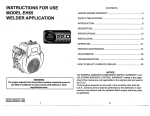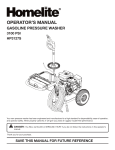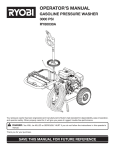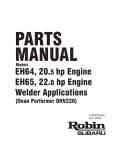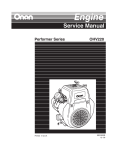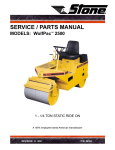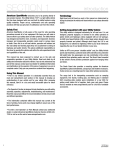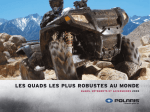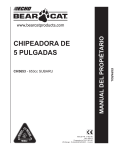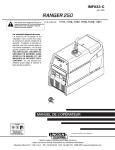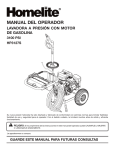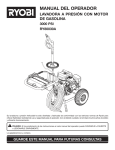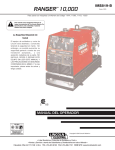Download Subaru Robin Power Products Welder EH64 User's Manual
Transcript
INSTRUCTIONS FOR USE MODEL EH64 WELDER APPLICATION CONTENTS LIMITED ENGINE WARRANTY ..........................................................3 SAFETY PRECAUTIONS....................................................................6 INTRODUCTION .................................................................................9 DESCRIPTION .................................................................................. 11 SPECIFICATIONS.............................................................................12 INSTALLATION .................................................................................13 OPERATION......................................................................................21 PERIODIC MAINTENANCE ..............................................................27 ADJUSTMENTS ................................................................................33 TROUBLESHOOTING ......................................................................35 HOW TO SELECT A SERVICE DEALER..........................................53 WARNING The engine exhaust from this product contains chemicals known to the State of California to cause cancer, birth defects or other reproductive harm. 2ZZ-90201-07 1 NOTICE The FEDERAL EMISSION COMPONENT DEFECT WARRANTY and CALIFORNIA EMISSION CONTROL WARRANTY stated in the beginning of this manual are only applicable to the engines sold and used in the U.S.A. To the engines exported to and used in the countries other than the U.S.A., warranty service shall be performed by the distributor in each country in accordance with the standard Robin engine warranty policy as applicable. 2 3 Year Limited Engine Warranty 6. (Special Term for Welder Application) Engine tune-ups and normal maintenance service including, but not limited to, valve adjustment, normal replacement of service items, fuel and lubricating oil, etc. 7. Any engine which has been subject to negligence, misuse, accident, misapplication or over-speeding. 8. Any engine that has been installed, repaired, or altered by anyone in a manner which in Robin’s sole judgment adversely affects its performance or reliability. 9. Any engine which has been fitted with or repaired with parts or components not manufactured or approved by Robin which in Robin’s sole judgment adversely affects its performance or reliability. (Effective with engines purchased from Robin America, Wood Dale, IL, after November 15, 1993) Robin America, Inc., a division of Fuji Heavy Industries, Ltd. (herein “Robin”), warrants that each new engine sold by it will be free, under normal use and service, from defects in material and workmanship for a period listed below from the date of sale to the original retail purchaser. Robin’s obligation under this Limited Warranty shall be limited to the repair and replacement, at Robin’s option, of any part or parts which upon examination is/are found, in Robin’s judgment, to have been defective in material or workmanship. It shall be a condition of Robin’s obligation under this Limited Warranty that Robin, directly or through one of its Distributors or Service Centers authorized to service the particular engine involved, receive prompt notice of any warranty claim and that the engine or the part or parts claimed to be defective be promptly delivered, transportation prepaid, to such Distributor or Service Center for inspection and repair. All repairs qualifying under this Limited Warranty must be performed by Robin or one of its authorized Distributors or Service Centers. WARRANTY PERIODS: Robin V-Twin, Welder ApplicationLimited 3 years Warranty (Applies to Original OEM installed engine) The repair or replacement of any part or parts under this Limited Warranty shall not extend the term of the engine warranty beyond the original term as set forth above. LIMITATIONS AND EXCLUSIONS: This Limited Warranty shall not apply to: 1. Bent or broken crankshaft or resultant damage caused by vibration related to a bent or broken crankshaft. Also, damage caused by loose engine mounting bolts or improper or imbalanced accessories or blades mounted to the crankshaft. 2. Repairs required because of prolonged storage including damage caused by old or contaminated fuel in the fuel tank, fuel lines or carburetor, sticky valves or corrosion and rust of engine parts. 3. Repair required due to overheating. (Most often caused by overloaded or clogged or damaged or missing flywheel, fan, inlet air passages, cooling fins or air shrouds.) 4. Dirt or grit related wear caused by improper air cleaner maintenance (most often 10. Instances when normal use has exhausted the life of a component or an engine. The customer is responsible for all transportation charges in connection with any warranty work. Robin reserves the right to modify, alter or improve any engines or parts without incurring any obligation to modify or replace, any engine or parts previously sold without such modification, alternation or improvement. No person is authorized to give any other warranty or to assume any additional obligation on Robin’s behalf unless made in writing and signed by an officer of Robin. THIS WARRANTY, AND ROBIN’S OBLIGATION HERE UNDER, ARE IN LIEU OF ANY OTHER WARRANTIES OR OBLIGATIONS OF ANY KIND, EXPRESSED OR IMPLIED, INCLUDING ANY WARRANTIES OF MERCHANTABILITY OR FITNESS FOR A PARTICULAR PURPOSE. THERE ARE NO WARRANTIES WHICH EXTEND BEYOND THE DESCRIPTION ON THE FACE HERE-OF. ROBIN SHALL IN NO EVENT BE LIABLE FOR ANY CONSEQUENTIAL OR INCIDENTAL DAMAGES. resulting in worn piston, piston rings, cylinders, valves, valve guides, carburetor or other internal components). 5. Broken or scored parts caused by low oil level, dirty or improper grade of oil. 3 4 WARNING : The engine exhaust from this product contains chemicals known to the State of California to cause cancer, birth defects or other reproductive harm. NOTICE FEDERAL EMISSION COMPONENT DEFECT WARRANTY and CALIFORNIA EMISSION CONTROL WARRANTY are applicable to only those engines complied with EPA (Environmental Protection Agency) and CARB (California Air Resources Board) emission regulations in the U.S.A. NOTICE For the engines exported to and used in the countries other than the U.S.A., warranty service shall be performed by the distributor in each country in accordance with the standard Robin engine warranty policy as applicable. Safety Precautions Before operating the engine, read this manual and become familiar with it and the equipment. Safe and efficient operation can be achieved only if the equipment is properly operated and maintained. The following symbols, found throughout this manual, alert you to potentially dangerous conditions to the operator, service personnel, or the equipment. ! DANGER This symbol warns of immediate hazards which will result in severe personal injury or death. ! WARNING This symbol refers to a hazard or unsafe practice which can result in severe personal injury or death. ! CAUTION This symbol refers to a hazard or unsafe practice which can result in personal injury or product or property damage. AIR INDEX To show compliance with California emission regulations, a hangtag has been provided displaying the Air Index level and durability period of this engine. The Air Index level defines how clean an engine’s exhaust is over a period of time. A bar graph scaled from “0” (most clean) to “10” (least clean) is used to show an engine’s Air Index level. A lower Air Index level represents cleaner exhaust from an engine. Fuels, electrical equipment, batteries, exhaust gases and moving parts present potential hazards that can result in severe personal injury. Take care in following these recommended procedures. All local, state and federal codes should be consulted and complied with. ! WARNING The period of time (in hours) that the Air Index level is measured is known as the durability period. Depending on the size of the engine, a selection of time periods can be used to measure the Air Index level (see below). Descriptive Term This engine is not designed or intended for use in any type of aircraft. Use of this engine in aircraft can result in engine failure and cause severe personal injury or death. Applicable to Emissions Durability Period Moderate - 50 hours (engine from 0 to 65 cc) 125 hours (engine greater than 65 cc) Intermediate - 125 hours (engine from 0 to 65 cc) 250 hours (engine greater than 65 cc) Extended - 300 hours (engine from 0 to 65 cc) 500 hours (engine greater than 65 cc) Notice : This hangtag must remain on this engine or piece of equipment, and only be removed by the ultimate purchaser before operation. 5 GENERAL • Provide appropriate fire extinguishers and install them in convenient locations. Use an extinguisher rated ABC by NFPA. • Make sure that all fasteners on the engine are secure and accurately torqued. Keep guards in position over fans, driving belts, etc. • If it is necessary to make adjustments while the engine is running, use extreme caution when close to hot exhausts, 6 moving parts, etc. • Used engine oils have been identified by some state and federal agencies as causing cancer or reproductive toxicity. When checking or changing engine oil, take care not to ingest, breathe the fumes, or contact used oil. • Do not work on this equipment when mentally or physically fatigued, or after consuming any alcohol or drug that makes the operation of equipment unsafe. BATTERIES • Before starting work on the engine, disconnect batteries to prevent inadvertent starting of the engine. Disconnect negative (-) cable first. • DO NOT SMOKE while servicing batteries. Lead acid batteries give off a highly explosive hydrogen gas which can be ignited by flame, electrical arcing or by smoking. • Verify battery polarity before connecting battery cables. Connect negative (-) cable last. PROTECT AGAINST MOVING PARTS • Do not wear loose clothing in the vicinity of moving parts, such as PTO shafts, flywheels, blowers, couplings, fans, belts, etc. • Keep your hands away from moving parts FUEL SYSTEMS • DO NOT fill fuel tank while engine is running • DO NOT smoke or use an open flame in the vicinity of the engine or fuel tank. Internal combustion engine fuels are highly flammable. • Fuel line must be made of steel tubing which adequately secured, and free from leaks. Tubing which connects to the carburetor should be factory approved flexible line. Do not use copper tubing as the flexible lines as copper will harden and become brittle enough to break. • Be sure all fuel supplies have a positive shutoff valve. • Benzene and lead, found in some gasoline, have been identified by some state and federal agencies as causing cancer or reproductive toxicity. When checking, draining, or adding gasoline take care not to ingest, breathe fumes, or contact the gasoline. 7 EXHAUST SYSTEM • Exhaust products of any internal combustion engine are toxic and can cause injury, or death it inhaled. When operating the engine in a confined area, make sure the ventilation system is operating properly. • DO NOT use exhaust gases to heat a compartment. • Make sure that your exhaust system is free of leaks. Make sure that exhaust manifolds are secure and are not warped by bolts unevenly torqued. EXHAUST GAS IS DEADLY! Exhaust gases contain carbon monoxide, a poisonous gas that can cause unconsciousness and death. It is an odorless and colorless gas formed during combustion of hydrocarbon fuels. Symptoms of carbon monoxide poisoning are: • Dizziness • Vomiting • Headache • Muscular Twitching • Throbbing in Temples • Weakness and Sleepiness If you experience any of these symptoms, get out into fresh air immediately, shut down the unit and do not use it until it has been inspected. The best protection against carbon monoxide inhalation is proper installation and regular, frequent inspections of the complete exhaust system. If you notice a change in the sound or appearance of exhaust system, shut the unit down immediately and have it inspected and repaired at once by a competent mechanic. KEEP THE UNIT AND SURROUNDING AREA CLEAN • Make sure that oily rags are not left on or near the engine. • Remove all unnecessary grease and oil from the unit. Accumulated grease and oil can cause overheating and subsequent engine damage and present a potential fire hazard. 8 Introduction ABOUT THIS MANUAL This manual covers the operation and maintenance of the horizontalshaft Robin Subaru EH64 engines for welder applications (OHV220 Performer Series). Each operator of the power equipment should study this engine manual carefully and observe all of its instructions and precautions. Proper use and periodic maintenance are responsibilities of the operator(s) and are essential for top performance. MODEL IDENTIFICATION Whenever contacting a dealer or distributor for information, parts or service, always provide the model number and the serial number marked on the nameplate of the engine. Robin engines are identified by MODEL, SPECIFICATION, and CODE NUMBER. For each model there may be many different versions called specifications. Each specification will be unique in some way. The difference may only be the paint color or it may have a different type of PTO or some other significant difference. In order to identify the correct service part number, it is important to confirm the specification and code numbers for your engine. The specification and code number together are know as the PRODUCT NUMBER. All Robin 4 cycle engine have a Product Number label similar to the label illustrated to the right. 9 10 Description Specifications FEATURES • Overhead valve arrangement enables high power, and low fuel and oil consumption • V-Twin, four stroke design • Air-cooled and gasoline fueled • The light weight and compact design makes it easy to install and utilize for many applications. • A steel crankshaft and high-load bearing offer durability • Pressure lubrication system and large capacity air cleaner enhance reliability of the engine. • The combustion chamber shape, along with a tuned exhaust valve system, enhance the low exhaust emission and provides high torque at low speed. Standard features include a fuel cut-of valve, a 12V-15 amp alternator and a pulse-type fuel pump. The flywheel-type governor gear provides constant operation at the selected speed against load variations. The carburetor is a down draft, float controlled fuel system with a fixed main jet. A fuel cut-off valve is provided to secure engine shut-down when the switch is turned off. Carburetors are calibrated for sure starting, good acceleration, low fuel consumption and adequate power output. A throttle solenoid (optional) automatically senses when the engine needs to run at full power and when it requires idle speed. The solenoid operates using a 15 second delay before dropping to idle. 11 Engine Type Air-Cooled, 4-Stroke, V-Twin Cylinder, Horizontal Shaft, OHV Gasoline Engine Rated Output 20.5 HP/3600 rpm (153. kW/3600) Continuous Output 16.0 HP/3600 rpm (11.9kW/3600) Bore X Stroke 80 mm x 65 mm (3.15” x 2.56”) Displacement 653cc (39.90 cu in) Compression Ratio 8.3:1 Maximum Output 15.3 kW/20.5 HP / 3600 rpm Maximum Torque 32.7 ft/lbs @ 2200 rpm Starting System Electric Start Carburetor Down draft, Float Type Fuel Unleaded Gasoline using a Diaphragm Pulse Pump Lubrication Full Pressure with full Flow Spin-On Filter Oil Type Automobile Engine Oil; Class SE Oil Capicity 1550 cc (1.64qt) Charging System 12 volt 15 amp Dry Weight 44 kg (96.9 lbs) Dimensions (L x W x H) 317mm x 477mm x 475mm (12.5” x 19.0” x 19.0”) Direction of Rotation CCW as Viewed from the PTO shaft side Cooling System Forced Air Cooling Ignition System Flywheel Magneto (Solid State) Spark Plug Type NGK-BP6ES or BRP6ES Governor System Centrifugal Fly Weight Air Cleaner Double Element Assembly Valve Clearance (Intake & Exhaust) 0.003-0.005 in (0.07-0.10mm) Emission Durability Period (California Only) 500 hours Installation LOCATING Locate the engine at least 1 meter (3.0 ft) away from buildings or other structures. Provide proper exhaust routing. Refer to EXHAUST SYSTEM below. Do not use the engine near flammables or other hazardous materials such as trash, rags, lubricants, or explosives. When determining the mounting location, make sure of the following: • Gas and oil can easily be checked and supplied • Oil can be changed. • The air cleaner can be serviced • Spark plugs can be checked. Carefully examine the engines position, the method of connecting it to a machine, and the foundation and support structure. Locate the engine in a safe area on a stable level surface free of small rock, loose gravel, etc. ! CAUTION carburetor. If the tank is mounted above the carburetor, a fuel shut-off valve must be connected between the fuel tank and the fuel pump. Note: To prevent fuel from flooding the carburetor, the fuel valve must be closed when the engine is not running. Properly install fuel lines to the carburetor bycompletely inserting the hose onto the fitting and then secure it with a hose clamp. ! WARNING Gaseous fuels are flammable and explosive and can cause severe personal injury or death. Do not smoke if you smell gas or are near fuel tanks or fuel-buring equipment or are in an area sharing ventilation with such equipment. Keep flames, sparks, pilot lights, electrical switches, arc-producing equipment and all other sources of ignition well away. Keep a type ABC fire extinguisher handy. Operating the engine on an incline may cause seizure due to improper lubrication; even at maximum oil level. EXHAUST SYSTEM EXHAUST GAS IS DEADLY! Engine-powered equipment must never be operated inside buildings or other enclosed spaces. If a long exhaust pipe is used, the internal resistance results in loss of engine power. The exhaust pipe ID must increase in proportion to exhaust pipe length. For example, if the exhaust pipe is: less than 3.0 m (9.8 ft.) long - pipe ID = 30mm (1-3/16in) less than 5.0 m (16.4 ft)long - pipe ID = 33mm (1.3in) It is the responsibility of the equipment operator(s) to check for exhaust leaks on a daily basis and to have all leaks repaired before continuing to operate the equipment. FUEL Fuel Tank The fuel tank system must be provided by the OEM. A fuel shut-off valve must connected between the fuel line and the fuel pump. The fuel tank may be mounted up to 0.66 meters (2.0ft) below the 13 Do not refill the fuel tank while the engine is running. Do not overfill the tank. Wipe away any spilled fuel and wait until it has dried before starting the engine. Fuel recommendations Use clean, fresh unleaded gasoline having a minimum octane rating (Anti-Knock Index) of 87. This engine is certified to operate on unleaded gasoline. During some periods of the year only mandated “oxygenated” gasolines may be available. These are acceptable for use, but not preferable. Do not use gasoline or gasoline additives (de-icers) containing methanol because methanol can be corrosive to fuel system components. ! CAUTION Do not use gasoline or gasoline additives containing methanol because methanol can be corrosive to fuel system components. 14 Installation ENGINE OIL Recommendations Use premium quality motor oil, Class SE or higher. Look for the SAE (Society of Automotive Engineers) or API viscosity grade. Referring to the table below, choose the viscosity grade appropriate for the ambient temperatures expected during the period of time until the next scheduled oil change. EXPECTED AMBIENT TEMPERATURES SAE VISCOSITY GRADE 32°F (0° C) and higher 30 0°F to 80°F (-18°C to 27°C) 10W-30 10W-40 Single-grade SAE 30 oil is preferable when temperatures are 50° and 90°F (10° - 32°C). If multi-grade oil is used, oil consumption tends to increase if the ambient temperature is high. Filling and Change Interval After the first 20 hours of operation the initial oil and oil filter should be replaced. Thereafter, change the oil every 100 hours of operation and change the oil filter every 200 hours. Apply a thin coat of oil to the oil filter gasket surface and install by tightening the oil filter about 3/4 turn after the seal has reached the crankcase surface. The oil capacity of the crankcase is 1.55L (53 fl.oz.). When filling the crankcase, keep the engine level and fill up to the upper mark of the oil gauge. Check the oil with the oil gauge pushed all the way in its seat. ! WARNING Crankcase pressure can blow hot engine oil out the fill tube causing severe burns. Always stop the engine before removing the oil fill cap or the oil gauge. 15 Check the oil level daily, before starting. Keep the oil level between the upper and lower level on the gauge. STARTING BATTERIES An engine equipped with an electric starter requires a properly sized battery along with appropriately sized interconnecting cables to insure proper starting. Neither cranking performance or starter service life will be satisfactory if an undersized battery is used. Use a battery rated 12V-30 amp or larger. The customer must supply battery cables. Use the table below to select the proper cable for the positive side connection. Connect a ground strap to the negative terminal. Use a flat strap 25.0mm (0.25”) wide. WIRE GAUGE CABLE LENGTH CABLE DIA. AWG (BS) BWG SAE JIS Less than 1.5m (4.5ft) 7.3mm (5/16 in.) 1 6 AV15 1.5 - 2.5m (4.5 - 7.6ft) 8.5 mm (3/8 in.) 0 4 AV20 2.5 - 4.0m (7.6 - 12.2ft) 108 mm (7/16in.) 3/0 2 AV30 16 Installation WIRING BATTERY CABLES The engine is equipped with a wiring harness that connects with the accessory. 1. Connect the positive (+) battery cable between the starter solenoid and the battery. 2. Connect the ground strap between the negative (-) battery terminal and a clean, bare metal grounding location on the engine. 3. Connect wires from starter key switch to starter solenoid and ground. WIRE GAUGE CABLE LENGTH CABLE DIA. AWG (BS) BWG SAE JIS Less than 1.5 m (4.5ft) 1.5mm (1/16in) 14 16 AV1.25 1.5-3.0m (4.5-9.8ft) 1.9mm (5/64in) 12 14 AV2 3.0-5.0m (9.8-16.4ft) 2.4mm (1/10in) 10 13 AV3 STARTER SWITCH A customer supplied starter switch or key switch is recommended for the starter motor. See table below for switch cable recommendations. 17 18 Wiring Diagram POWER TRANSMISSION Belt Drive If using a belt drive application, consider the following notes: • V-belts are preferable to flat belts • The engine drive shaft must be parallel to the machine drive shaft • The engine drive pulley must be in line with the machine drive pulley • Install the engine pulley as close to the engine as possible • Span the drive belt horizontally, if possible. ENGINE WIRING DIAGRAM (6 PIN) Engine Specification Numbers: EH650DB2332 EH650DB2341 EH650DB2390 • Disengage the load when starting the engine. • Use a belt tension pulley if a clutch is not used. Flex Coupling When using a flex coupling, minimize run-out and misalignment between the drive shaft and the engine shaft. The run-out and misalignment tolerances are specified by the coupling manufacturer. ENGINE WIRING DIAGRAM (4 PIN) Engine Specification Number: EH650DB2332 19 20 Operation any indications of fuel leakage. Do not operate engine until all leaks are repaired. ! WARNING EXHAUST GAS IS DEADLY! Exhaust gases contain carbon monoxide, an odorless and colorless gas. Carbon monoxide is poisonous and can cause unconsciousness and death. Symptoms of carbon monoxide poisoning include: • Dizziness • Throbbing in Temples • Nausea • Muscular Twitching • Headache • Vomiting • Weakness and Sleepiness • Inability to Think Coherently IF YOU OR ANYONE ELSE EXPERIENCE ANY OF THESE SYMPTOMS, GET INTO THE FRESH AIR IMMEDIATELY. If symptoms persist, seek medical attention. Shut down the engine and do not operate it until it has been inspected and repaired. Make certain the exhaust system is properly installed. Inspect it every time the engine is started and after every eight hours of continuous operation. PRE-START CHECKS Before the first start of the day and after every eight hours of operation perform the maintenance procedures in DAILY (8 HOUR) MAINTENANCE in the Maintenance Section. Keep a log of maintenance and the running hours. Perform any maintenance that may be due. If the equipment has been in storage, return the engine to service as instructed under RETURNING THE ENGINE TO SERVICE in this section. 1. Inspect exhaust system for loose joints, rusty, worn or damaged areas. Do not operate engine until all leaks are repaired. 2. Check the fuel level and refill if necessary. Open the fuel shut-off valve (if equipped). 3. Make sure fuel hoses and connections are tight. Check for 21 4. Check and tighten any loose bolts or nuts. 5. Check the oil and refill, if necessary. Do not overfill. ! CAUTION Starting the engine without oil will cause severe engine damage. Always keep the engine oil level between the Full and Add marks on the dipstick. 6. Wear snug fitting clothes when operating the engine. Loose articles of clothing could get caught in the engine or drive train. ! WARNING Moving parts can cause severe personal injury or death. Hot exhaust parts can cause severe burns. Stay clear of hot or moving parts. Make sure all protective shields and guards are secure in place before starting the equipment. STARTING 1. Move the choke lever to the full-choke position. On equipment with a solenoid operated choke, push the switch to its choke position. In warm weather, however, or when the engine is warm, try starting without the choke or in the half-way position. 2. Turn the ignition switch to START and hold it there until the engine starts. Do not crank for more than 5 seconds at a time. If the engine fails to start, set the switch to RUN and wait 10 seconds before the next attempt. See Troubleshooting if the engine does not start after several tries. Never turn the switch to START while the engine is running. 22 3. After the engine starts, slowly push the choke to the fullopen position. Pull it back, if necessary, to keep the engine running smoothly until the engine is at operating temperature In colder weather, the engine will take longer to begin running smoothly with the choke open. Do not operate the equipment until the choke is fully open. OPERATING IN DUSTY CONDITIONS 1. Keep the engine cooling fins and flywheel air inlet screen clean. 2. Perform air cleaner maintenance more often than normal-as required. 3. Change the engine oil and oil filter more often than normal. STOPPING HOT AND COLD WEATHER PRECAUTIONS To stop the engine turn the switch to the STOP position. Hot Weather ENGINE BREAK-IN Pay particular attention to the following items when operating the engine in temperatures above 100°F (38°C): For top engine performance, new or rebuilt engines require a breakin period to obtain the ideal fitting of internal moving metal parts. To break-in the engine: 1. Keep the flywheel air inlet screen and cylinder cooling fins clean. Make sure that nothing obstructs air flow to and from the engine 1. Run the engine at 2500 rpm, without a load, for 10 minutes. 2. Run the engine at 3,000 rpm for 10 minutes. 2. Check the oil level more frequently. 3. Change the oil and oil filter more often than normal. 3. Run the engine at 3,600 rpm for 10 minutes. 4. Make sure the engine oil viscosity is appropriate for the ambient temperatures and change the oil if necessary. 4. Run the engine with a load of 8HP at 3,600 rpm for 30 minutes. Cold Weather 5. Run the engine with a load of 16HP at 3,600 rpm for 30 minutes. Pay particular attention to the following items when operating the engine in temperatures blow freezing: Frequently check for oil leaks during break-in. After the first 20 hours of normal operation, change the oil and oil filter. Refer to Maintenance for procedures. 23 1. Make sure the engine oil viscosity is appropriate for the ambient temperatures and change the oil if necessary. If the temperature drops before you have the chance to change the oil, warn the engine by moving the equipment into a heated space before attempting to start the engine or change the oil. 24 ! WARNING EXHAUST GAS IS DEADLY! Never operate engine-powered equipment indoors without a proper exhaust system, ample fresh air ventilation and an operable carbon monoxide detector. 2. Use fresh gasoline and fill the fuel tank after each day’s use to reduce problems with moisture condensation if this is a gasoline engine. 3. Keep the battery in a well-charged condition. 4. After each use push the equipment throttle knob or lever to the middle of its speed range. Then, if ice forms on the linkage during storage it will be easier to start the engine. 6 Perform air cleaner maintenance as instructed in Periodic Maintenance. 7 Plug the exhaust outlet to prevent moisture, dirt, bugs, ect. from entering. ! WARNING Battery gas is explosive. Wear safety glasses and do not smoke while servicing batteries. Lead acid batteries give off a highly explosive hydrogen gas which can be ignited by flame, electrical arcing or smoking. 8 Disconnect the battery (negative (-) cable first) and follow the battery or equipment manufacturer’s storage instructions. 9 Cover the engine with a plastic sheet or canvas and store in a dry place. OUT-OF-SERVICE PROTECTION RETURNING THE ENGINE TO SERVICE Protect an engine that will be out of service for more than 30 days as follows: 1 Remove the cover and all protective wrapping and the plug from the exhaust outlet. 1 Run the engine until it reaches normal operating temperature then, shut-off the fuel supply and let the engine run until it stops. 2 Check the tag on the oil base. Change the oil if the viscosity is not appropriate for the expected ambient temperatures. 2 If the equipment will not be operated for more than 30days, add a fuel preservative (ie. Sta-Bil) to the equipment fuel tank. Follow the instructions on the container label. Unless a preservative is added, gasoline will deteriorate causing fuel system corrosion, gum formation and varnish-like deposits which can lead to hard starting and rough operation. 3 Check the fuel filter and fuel lines to make sure they are secure and have no cracks. 3 Drain oil from the engine while it is still warm. Refill with fresh oil and attach a tag stating the viscosity of the oil used. 4 To prevent rust in the cylinder bore, remove the spark plug and pour 30mL (2 tbsp. or 1oz.) of SAE 30 oil in the opening. Turn the crankshaft several times by hand and reinstall the spark plug. 4 Check that the choke, throttle and governor linkages move freely. 5 If so equipped, clean and check the battery according to the battery or equipment manufacturer’s instructions and connect the battery cables (positive (+) cable first). 6 Start the engine. The initial startup may be slow and there may be smoke and rough operation for a few minutes until the oil in the cylinder burns off. If the engine does not start, clean or replace the spark plug as it may have been fouled by the oil added to the cylinder when the equipment was stored. 5 Clean the outside of the engine with an oiled cloth. 25 26 Periodic Maintenance Periodic Maintenance MAINTENANCE, REPLACEMENT, OR REPAIR OF THE EMISSION CONTROL DEVICES AND SYSTEMS MAY BE PERFORMED BY NON-ROAD ENGINE REPAIR ESTABLISHMENTS OR INDIVIDUALS. Periodic maintenance is essential for top engine performance. See the Table below as a guide for normal periodic maintenance. Under hot or dusty operating conditions some maintenance operations should be performed more frequently, as indicated by footnotes in the table. FREQUENCY MAINTENANCE OPERATION Daily or Every 8 Hours Clean Dust and Debris from Engine X Check fuel leakage from fuel system. Retighten fasteners or replace parts if needed. X1 Inspect for Loose Hardware and Retighten X Check Oil Level and Add to Full Level X Every 50 Hours Every 100 Hours Every 200 Hours Every 500 Hours Every 1,000 Hours Keep a log of maintenance performed and the run time hours. Keeping a record of procedures will help you keep scheduled maintenance and provide a basis for supporting warranty claims Maintenance, replacement or repair of emission control devices and systems may be performed by any engine repair establishment or individual. However, warranty work must be done completed by an authorized Robin Subaru dealer or distributor. DAILY (8 HOUR) MAINTENANCE The operator should check the following before the first start of the day and after every eight hours of operation: 1 Inspect fuel lines and fittings for leaks. Repair leaks immediately. 2 Look and listen for exhaust system leaks while the engine is running. Look for cracks and severe rusting in the muffler and tailpipe. Have all leaks repaired before continuing to operate the equipment. X2,4 Change Engine Oil Check Battery Fluid Level X5 Clean Spark Plugs X Clean Outer Element of Air Cleaner X ! WARNING Hot exhaust parts can cause severe burns. Allow the engine time to cool before servicing the exhaust system. Clean Fuel Strainer X Replace Air Cleaner Assembly X Inspect, Clean and Re-Gap Spark Plugs 3 Check the engine for dirt and debris and clean the flywheel air inlet screen and cylinder cooling fins as necessary. X ! CAUTION A clogged flywheel air inlet screen or dirty cooling X3,4 Change Engine Oil Filter Clean Carburetor X Clean Cylinder Head X Adjust Engine Valve Clearance X6 Replace Spark Plugs X Replace Fuel Lines and Filter fins can cause overheating and engine damage. Keep the cooling fins and air inlet screen clean. X 1. Check for oil, fuel and exhaust leaks, loose parts and unusual noises and vibrations. 2. Change oil and filter after the first 20 hours of operation as a part of engine break-in. 3. Perform more often when operating in dusty conditions. 4. Perform more often when operating in hot conditions. 5. See instructions for battery care provided by the equipment or battery manufacturer. 6. Must be performed by a qualified mechanic (equipment or Robin dealer). 27 4 Check the engine oil level The equipment must be parked on a level surface ad the engine stopped. To get an accurate reading, wait a minute or so to allow the oil to settle in the crankcase if the engine has been running. 28 ! WARNING Crankcase pressure can blow hot engine oil out the fill tube causing severe burns. Always stop the engine before removing the oil fill cap. If the engine is equipped with the long oil fill tube, turn the oil fill cap counterclockwise and lift it up. Wipe the dip stick clean, push it back into the oil fill tube until the cap seats. Withdraw it again to check the oil level. CHANGING OIL AND FILTER Change the oil and filter after the first 20 hours of operation. Thereafter, change oil every 50 hours and the filter every 200 hours. ! WARNING State and federal agencies have determined that contact with used engine oil can cause cancer or reproductive toxicity. Take care to limit skin contact and breathing of vapors as much as possible. Use rubber gloves and wash exposed skin. 1 Run the engine until it is warm. Stop the engine and disconnect the spark plug wires and the battery (negative (-) cable). 4 Place a pan under the oil drain opening and open the oil drain plug. Close the plug securely after the oil has drained completely. ! WARNING Accidental starting of the engine can result in severe 7 Make sure the gasket is in place on the filter canister and apply a thin film of oil to the gasket. personal injury or death. Always disconnect the spark plug wires and the battery (negative (-) cable) before changing oil. 2 Remove the oil fill cap. ! WARNING Crankcase pressure can blow hot engine oil out the fill opening causing severe burns. Always stop the engine before removing the oil fill cap. 5 Spin off the oil filter, drain the oil and discard the filter according to local regulations. 6 Thoroughly wipe off the filter mounting surface. 8 Spin the new filter on by hand until the gasket just touches the mounting surface, then turn it an additional 1/2 to 3/4 turn. Do not overtighten. 9 Refill with class SE (API) of higher having a viscosity grade appropriate for the expected ambient temperature. 3 To drain oil from crankcase, loosen the drain valve then twist the outer casing to unlock. The valve is fitted with an adapter for a drain tube if desired. 29 30 10 DO NOT FILL TO A LEVEL ABOVE THE FULL MARK ON THE DIPSTICK. Drain the excess oil if too much has been added. Foam Filter Remove and wash the urethane foam in water and detergent. Squeeze the foam wrapper dry like a sponge. Rinse with clean water and allow it to dry. Coat the wrapper evenly with 14 mL (one tbsp.) of SAE 30 engine oil. Knead the oil into the wrapper and squeeze out the excess oil. Note: Failure to adequately wring out excess oil from the wrapper may cause a drop in engine power due to restriction of inlet air. Install the foam wrapper over the paper air cleaner element by stretching it over the inner cover. Completely cover all exposed paper pleats. Replace the air cleaner assembly when it becomes torn or stretched. Air Cleaner Element Replacement ! CAUTION Too much oil can cause high oil consumption, high operating temperatures and oil foaming. Too little oil can cause severe engine damage. Keep the oil level between the Full and Add marks on the dipstick. 11 Reconnect the spark plug wires and battery. 12 Start the engine and run it for a short time while checking for oil leaks around the drain plug and oil filter. Do not overtighten: tighten only as necessary to eliminate leaks. To keep anything from entering the carburetor and engine while the air cleaner element is off, pull the choke knob to the full-choke position to close the choke plate in the carburetor. Remove the outer cover and wipe away loose dust and debris from the air cleaner assembly. Remove the air cleaner assembly. Wipe off dust and debris from the air cleaner base. Use forced air to blow off dust and debris from the paper element. Reinstall the paper element on the engine. Replace the foam wrapper and outer cover. Secure with the wing nut. Used oil is harmful to the environment. Pour the used oil into a sealed container and deliver it to the nearest recycling center. AIR CLEANER MAINTENANCE Refer to the Maintenance Table for the air cleaner assembly. Outer Cover To remove the air cleaner cover, rotate the wing nut counterclockwise and remove. 31 Element Set P/N 263-32610-A1 32 SPARK PLUG MAINTENANCE AND REPLACEMENT To adjust the speed control solenoid: Refer to the Specifications for spark plug type and gap specifications. Check and clean spark plugs every 200 hours. Replace plugs every 500 hours. 1 Run the engine with no load until the engine control times out (about 15 seconds) and energizes the solenoid. To prevent cross threading the spark plug, always thread it in by hand until it seats. If the spark plug is being reused, turn it with a wrench and additional 1/4 turn. If the spark plug is new, turn it an additional 3/8 to 1/2 turn. If you have a torque wrench, tighten a new spark plug to 11.8-14.7 N-m (120-150 Kg/cm) (8.7-10.9 ft/lb). CHECKING BATTERIES 2 Adjust engine to 2200 RPM by loosening the two slotted screws retaining the solenoid. 3 Slide solenoid forward to increase the speed, or backwards to decrease the speed. 4 Retighten the two screws. Every 50 hours or once a month check the fluid level of the battery. Refill with distilled water if levels are low. Following reassembly of either the carburetor or intake manifold, realign the governor arm on the governor shaft BEFORE making speed adjustments to compensate for the slightly different alignment of parts. ! WARNING Battery gas is explosive. Wear safety glasses and do Governor and Speed Control Assembly not smoke while servicing batteries. Lead acid batteries give off a highly explosive hydrogen gas which can be ignited by flame, electrical arcing or smoking. 1 2 ! WARNING If the battery is to be replaced, disconnect the 3 negative cable first, and reconnect it last. 6 4 Adjustments 5 7 CARBURETOR ADJUSTMENTS These engines have precision-manufactured carburetors which are not adjustable. Engine Speed Solenoid (Optional) Normally, the engine speed does not require any adjustment. These instructions are for the equipment manufacturer in setting up and adjusting the equipment. 1 2 3 4 5 6 7 Speed Control Solenoid Adjust Screw (2) (Optional) Governor Adjust Screws Governor Lever Speed Control High Stop Adjust Screw Manual Throttle Control Link Low Idle Adjust Screw Choke Control Linkage The speed control solenoid monitors the rate of the load and automatically adjusts the engine to the appropriate idle speed. 33 34 Speed Control Adjustments Engine speed adjustment must be attempted only by a qualified mechanic and the adjustments must be made using an accurate tachometer. It is recommended that low-idle speed be adjusted between 1800 to 2200 RPM and high idle speed 3700 to 3800 RPM. Check in your welder manufacture’s manual for exact speed settings. Engine Starting Engine cranks but fails to start Fuel Supply. Check fuel supply and shut-off valve. Check fuel filter and clean if dirty. Check fuel filter: clean or replace if dirty. Check fuel line connections into carburetor for air leaks. Fuel. Gasoline may have water mixed in or the gasoline grade is not correct. Troubleshooting The table below provides basic troubleshooting guidance. If you fail to resolve the problem after taking the corrective actions suggested, contact the equipment manufacturer or a Robin Subaru dealer. Carburetor problems. Flooding carburetor, the float may be bad or stuck. Varnish build up deposits in the carburetor, the carburetor will have to be disassembled. Governor and throttle linkage. Check linkage connections. Check tension in springs. Check governor, throttle and speed adjustments . The fuel cut-off solenoid is faulty. Check for lose or damaged wires and connectors. Check voltage levels at the connector to the solenoid. Replace harness or solenoid. Check air cleaner and service if dirty. ! WARNING Many troubleshooting procedures present hazards that can result in severe personal injury. Only qualified service personnel with knowledge of fuels, electricity, and machinery hazards should perform service procedures. Review the safety precautions on the inside cover page. ! WARNING Hot engine parts can cause severe burns. Always Engine Starting Electric starter does not operate allow the engine time to cool before performing any maintenance or service. Problem Probable Cause and Remedy Engine Starting Engine cranks slowly or not at all Poor battery connections: Clean and tighten the positive (+) and negative (-) connections at battery and engine. Back pressure: There is excessive back pressure due to a plugged or bent exhaust pipe. No continuity between the key switch and the starter. Replace wires. Low battery. Change or recharge battery. Starter solenoid is bad. Check voltages, clean repair, or replace. Starter motor is bad. Check brushes and wiring, repair or replace. Engine seizure. The crankshaft has seized or the piston and cylinder have seized. Check crankshaft bearings and bearing surface. 1 Electric starter is faulty: Check starter brushes and bearings. There is a load on the engine: Remove load and retry. Key or start switch. Check wiring connections and switch. No continuity between the battery and starter. Replace cable. Battery is not fully charged: Recharge the battery. Improper engine oil: Change oil having the proper viscosity for the ambient temperature. Damaged spark plug(s). Check the spark plug gap. Check for a bad insulator on plug and replace if damaged. Clean carbon deposit from electrode. Id wet, dry electrode. Engine Starting Electric starter operates but engine does not start Low fuel. Poor wiring connection or no continuity of ignition system. Check wiring connections and ignition coils for a short. Electric starter is bad. Slow cranking RPM is caused by low voltage at starter or worn brushes or bearings. Repair or replace. Engine Overheats Air flow is obstructed at inlet or cylinder baffle. Clean out debris in baffle. Improper engine oil. Replace oil. Lean air/fuel mixture. Check for plugged passages in carburetor. Excessive back pressure on exhaust. Check muffler and spark arrester. Engine is overloaded. Change to rated load. Engine Idles Rough Low idle speed. Adjust idle on carburetor. Air is mixing at air intake connection. Check, tighten or replace gasket.1 There is blow-by on the head gasket. Replace the gasket. 1 Improper valve clearance. Adjust clearance. 1 Excessive clearance between valve stem and guide. Replace valve stem and guides.1 IMPORTANT INFORMATION FOR CALIFORNIA ENGINE USERS These engines meet the requirements of California’s Exhaust Emissions Standards for 1995 and later for Utility and Lawn and Garden Equipment Engines. As a California user of these engines, please be aware that unauthorized modifications or replacement of fuel, exhaust, air intake, or speed control system components that affect engine emissions are prohibited. Unauthorized modifications, removal or replacement of the engine label is prohibited. You should carefully review Operator (Owner), Installation and other manuals and information you receive with your engine or equipment. If you are unsure that the installation, use, maintenance or service of your engine or equipment is authorized, you should seek assistance from an approved Robin Subaru engine dealer or an approved dealer for your equipment. California engine users may use Table 1-1 as an aid in locating information related to the California Air Resources Board requirements for emissions control. TABLE 1-1 EMISSION CONTROL INFORMATION Engine Warranty Information Engine Support Material Robin America has established the Robin Subaru Fulfillment Center to take and ship orders to anyone wanting Robin Subaru reference material. This allows for the prompt fulfillment of Robin Subaru part and service manuals, counter catalogs, price books and other support material to dealers and end users at the lowest possible price. Robin Fulfillment Center PO Box 6978 • Rockford, IL 61125-1978 USA Phone: 888-576-2465 • Fax: 630-563-0403 website: www.robinsubaru.com • email: [email protected] 37 The California emissions control warranty statement is located the back of this manual Engine Valve Lash See Specifications Engine Ignition Timing See Specifications Engine Fuel Requirements This engine is certified to operate on unleaded gasoline. See Fuel Recommendations in Introduction. Engine Lubricating Oil Requirements See Engine Oil Recommendations in Introduction. Engine Fuel Mixture Settings These engine have precision-manufactured carburetors which are not adjustable Engine Adjustments See Adjustments Engine Emission Control System The engine emission control system consists of internal engine modifications. 38 FEDERAL EMISSIONS COMPONENT DEFECT WARRANTY EMISSIONS COMPONENT DEFECT WARRANTY COVERAGE - This emission warranty is applicable in all States, except the State of California *The replacement parts used for required maintenance services. Fuji Heavy Industries Ltd. and Robin America Inc., Wood Dale Illinois, (herein "ROBIN AMERICA") warrant(s) to the initial retail purchaser and each subsequent owner, that this Nonroad engine (herein "engine") has been designed, built, and equipped to conform at the time of initial sale to all applicable regulations of the U.S. Environmental Protection Agency (EPA), and that the engine is free of defects in materials and workmanship which would cause this engine to fail to conform with EPA regulations during its warranty period. *Diagnosis and inspection charges that do not result in warranty-eligible service being performed. For the components listed under PARTS COVERED, the service dealer authorized by ROBIN AMERICA will, at no cost to you, make the necessary diagnosis, repair, or replacement necessary to ensure that the engine complies with applicable U.S. EPA regulations. *Consequential damages such as loss of time, inconvenience, loss of use of the engine or equipment, etc. *Any non-authorized replacement part, or malfunction of authorized parts due to use of non-authorized parts. OWNER'S WARRANTY RESPONSIBILITIES As the engine owner, you are responsible for the performance of the required maintenance listed in your owner's manual. ROBIN AMERICA recommends that you retain all receipts covering maintenance on your engine, but ROBIN AMERICA cannot deny warranty solely for the lack of receipts or for your failure to ensure the performance of all scheduled maintenance. EMISSION COMPONENT DEFECT WARRANTY PERIOD As the engine owner, you should however be aware that ROBIN AMERICA may deny warranty coverage if your engine or a part has failed due to abuse, neglect, improper maintenance or unapproved modifications. The warranty period for this engine begins on the date of sale to the initial purchaser and continues for a period of 2 years. You are responsible for presenting your engine to the nearest service dealer authorized by ROBIN AMERICA when a problem exists. PARTS COVERED If you have any questions regarding your warranty rights and responsibilities, you should contact the Robin America customer service department at 1-630-350-8200 for the information. Listed below are the parts covered by the Emission Components Defect Warranty. Some of the parts listed below may require scheduled maintenance and are warranted up to the first scheduled replacement point for that part. THINGS YOU SHOULD KNOW ABOUT THE EMISSION CONTROL SYSTEM WARRANTY MAINTENANCE AND REPAIRS (3) Ignition System (1) Fuel Metering System (i) Carburetor and internal parts (and/or pressure regulator or fuel injection system). (i) Spark plugs. (ii) Air/fuel ratio feedback and control system, if applicable. (iii) Spark advance/retard system, if applicable. (iii) Cold start enrichment system, if applicable. (ii) Magneto or electronic ignition system. You are responsible for the proper maintenance of the engine. You should keep all receipts and maintenance records covering the performance of regular maintenance in the event questions arise. These receipts and maintenance records should be transferred to each subsequent owner of the engine. ROBIN AMERICA reserves the right to deny warranty coverage if the engine has not been properly maintained. Warranty claims will not be denied, however, solely because of the lack of required maintenance or failure to keep maintenance records. (4) Exhaust manifold, if applicable (5) Miscellaneous Items Used in Above Systems (iv) Regulator assy (gaseous fuel, if applicable) (i) Electronic controls, if applicable (ii) Hoses, belts, connectors, and assemblies. (2) Air Induction System (i) Intake manifold, if applicable (iii) Filter lock assy (gaseous fuel, if applicable) (ii) Air filter. MAINTENANCE, REPLACEMENT OR REPAIR OF EMISSION CONTROL DEVICES AND SYSTEMS MAY BE PERFORMED BY ANY REPAIR ESTABLISHMENT OR INDIVIDUAL ; HOWEVER, WARRANTY REPAIRS MUST BE PERFORMED BY A SERVICE DEALER AUTHORIZED BY ROBIN AMERICA. THE USE OF PARTS THAT ARE NOT EQUIVALENT IN PERFORMANCE AND DURABILITY TO AUTHORIZED PARTS MAY IMPAIR THE EFFECTIVENESS OF THE EMISSION CONTROL SYSTEM AND MAY HAVE A BEARING ON THE OUTCOME OF A WARRANTY CLAIM. OBTAINING WARRANTY SERVICE To obtain warranty service, take your engine to the nearest authorized Robin America service dealer. Bring your sales receipts indicating date of purchase for this engine. The service dealer authorized by ROBIN AMERICA will perform the necessary repairs or adjustments within a reasonable amount of time and furnish you with a copy of the repair order. All parts and accessories replaced under this warranty become the property of ROBIN AMERICA. If other than the parts authorized by ROBIN AMERICA are used for maintenance replacements or for the repair of components affecting emission control, you should assure yourself that such parts are warranted by their manufacturer to be equivalent to the parts authorized by ROBIN AMERICA in their performance and durability. HOW TO MAKE A CLAIM WHAT IS NOT COVERED *Conditions resulting from tampering, misuse, improper adjustment (unless they were made by the service dealer authorized by ROBIN AMERICA during a warranty repair), alteration, accident, failure to use the recommended fuel and oil, or not performing required maintenance services. 39 All repair qualifying under this limited warranty must be performed by a service dealer authorized by ROBIN AMERICA. In the event that any emission-related part is found to be defective during the warranty period, you shall notify Robin America customer service department at 1-630-350-8200 and you will be advised of the appropriate warranty service dealer or service providers where the warranty repair can be performed. 40 CALIFORNIA EMISSION CONTROL WARRANTY STATEMENT YOUR WARRANTY RIGHTS AND OBLIGATIONS LIMITED WARRANTY on Emission Control Systems - California Only - The California Air Resources Board and Fuji Heavy Industries Ltd. (herein "FUJI") are pleased to explain the emission control system warranty on your 2004 and later Small Off-Road engine (herein "engine"). In California, the engine must be designed, built and equipped to meet the State's stringent anti-smog standards. FUJI must warrant the emission control system on your engine for the periods of time described below, provided there has been no abuse, neglect or improper maintenance of your engine. Your emission control system may include parts such as the carburetor or fuel-injection system, and the ignition system. Also included may be hoses, belts, connectors and other emission-related assemblies. Where a warrantable condition exists, FUJI will repair your engine at no cost to you including diagnosis, parts and labor. FUJI warrants to the owner of the 2004 and later engine that the engine (1)has been designed, built and equipped so as to conform at the time of manufacture with the applicable regulations of the California Air Resources Board, and (2) is free from defects in materials and workmanship that could cause it to fail to conform with those regulations as may be applicable in the terms and conditions stated below. MANUFACTURER'S WARRANTY COVERAGE : B. LENGTH OF COVERAGE The 2004 and later engines are warranted for two (2) years. If any emission related part on your engine is defective, the part will be repaired or replaced by FUJI. FUJI warrants to a first retail purchaser and each subsequent purchaser that the engine is free from defects in materials and workmanship that cause the failure of a warranted emissionrelated part for a period of two (2) years after the date of delivery to the first retail purchaser. OWNER'S WARRANTY RESPONSIBILITIES : -As the engine owner, you are responsible for the performance of the required maintenance listed in your Owner's Manual. FUJI recommends that you retain all receipts covering maintenance on your engine, but FUJI cannot deny warranty solely for the lack of receipts or for your failure to ensure the performance of all scheduled maintenance. -As the engine owner, you should ,however, be aware that FUJI may deny you warranty coverage if your engine or a part has failed due to abuse, neglect, improper maintenance or unapproved modifications. -You are responsible for presenting your engine to a service dealer or warranty station authorized by ROBIN AMERICA Inc. 940 Lively Blvd., Wood Dale, IL 60191 (herein ROBIN AMERICA) as soon as a problem exists. The warranty repairs should be completed in a reasonable amount of time, not to exceed 30 days. If you have any questions regarding your warranty rights and responsibilities, you should contact the Robin America Inc. Customer Service Department at 1-630-350-8200 A. COMMENCEMENT DATE The warranty period begins on the date the engine is delivered to a first retail purchaser. C. WHAT IS COVERED : 1. REPAIR OR REPLACEMENT PARTS Repairs and replacement of any warranted part will be performed at no charge to you by an authorized service dealer or a warranty station. You may contact the Robin America Inc. Customer Service Department at 1-630-350-8200 to obtain the name of the nearest appropriate location where your warranty repairs are performed. 2. WARRANTY PERIOD This warranty continues for a period of two (2) years and applies only to the repair, replacement or adjustment of the component parts that are not scheduled for replacement as required maintenance. Further, component parts which are scheduled only for regular inspection to the effect of "repair or replace as necessary" are warranted for the warranty period. Any warranted part which is scheduled for replacement as required maintenance is warranted for the period of time up to the first scheduled replacement point for that part. 3. DIAGNOSIS You will not be charged for diagnostic labor that leads to the determination that a warranted part is defective, if the diagnostic work is performed at an authorized service dealer or warranty station. 4. DAMAGES If a warranted part failed causing damage to other engine components, consult an warranty station. D. WHAT IS NOT COVERED 1. This limited warranty does not cover any part which malfunctions, fails or is damaged due to failure to follow the maintenance and operating instructions set forth in the 2004 and later Owner's Manual including: (1) improper maintenance of any warranted parts (2) improper installation, adjustment or repair of the engine or of any warranted part unless performed by an authorized service dealer (3) failure to follow recommendations on fuel use contained in the 2004 and later Owner's Manual 41 42 (4) repairs performed outside of the authorized warranty service dealers (5) use of parts which are not authorized by FUJI. 2. Add-on or modified parts This warranty does not cover any part that malfunctions, fails or is damaged due to alterations by changing, adding to or removing parts from the engine. 3. Expenses incurred by processing warranty claims FUJI, any authorized service dealer and warranty station shall not be liable for any loss of use of the engine, for any alternative usage, for any damage to goods, loss of time or inconvenience. E. HOW TO FILE A CLAIM All repairs qualifying under this Limited Warranty must be performed by a dealer who sold you the engine or warranty station authorized by ROBIN AMERICA. In the event that any emissionrelated part is found to be defective during the warranty period, you must notify the Robin America Inc. Customer Service Department at 1-630-350-8200 and you will be advised of the appropriate warranty service facilities where the warranty repair is to be performed. F. WHERE TO OBTAIN WARRANTY SERVICE It is recommended that warranty service be performed by the authorized dealer who sold you the engine, although warranty service will be performed by any authorized service dealers or warranty stations anywhere in the United States. When warranty repair is needed, the engine must be brought to an authorized service dealer or warranty station's place of business during normal business hours. In all cases, a reasonable time, not to exceed 30 days, must be allowed for the warranty repair to be completed after the engine is received by the authorized service dealer or warranty station. (5) Miscellaneous Items Used in Above Systems (i)Electronic controls, if applicable (ii)Hoses, belts, connectors, and assemblies. (iii) Filter lock assy (gaseous fuel, if applicable) I. MAINTENANCE STATEMENTS It is your responsibility to have all scheduled inspection and maintenance services performed at the times recommended in the 2004 and later Owner's Manual and to retain proof that inspection and maintenance services are performed at the times when recommended. FUJI will not deny a warranty claim solely because you have no record of maintenance; however, FUJI may deny a warranty claim if your failure to perform required maintenance resulted in the failure of warranted part. The proof which you maintain should be given to each subsequent owner of the engine. You are responsible for performing the scheduled maintenance described below based on the procedures specified in the 2004 and later Owner's Manual. The scheduled maintenance below is based on a normal engine operating schedule. PROCEDURE INTERVAL 1) Change engine oil : Initial 20 hours and every 100 hours afterward 2) Clean air cleaner (element) : Every 50 hours 3) Replace air cleaner element : Every 200 hours 4) Clean and adjust spark plug and electrodes : Every 200 hours Note : More frequent maintenance may be necessary under dusty, dirty or severe conditions. G. MAINTENANCE, REPLACEMENT AND REPAIR OF EMISSION-RELATED PARTS Only warranted engine replacement parts approved by FUJI should be used in the performance of any warranty maintenance or repairs on emission-related parts. If other than authorized parts are used for maintenance, replacement or repair of components affecting emission control, you should assure yourself that such parts are warranted by their manufacturer to be equivalent to authorized parts in performance and durability. FUJI ,however, assumes no liability under this warranty with respect to parts other than authorized parts. The use of non-authorized replacement parts does not invalidate the warranty on other components unless the nonauthorized parts cause damage to warranted parts. H. PARTS COVERED UNDER THE CALIFORNIA EMISSIONS WARRANTY (1) Fuel Metering System (i) Carburetor and internal parts (and/or pressure regulator or fuel injection system). (ii) Air/fuel ratio feedback and control system, if applicable. (iii) Cold start enrichment system, if applicable. (iv) Regulator assy (gaseous fuel, if applicable) (2) Air Induction System (i)Intake manifold, if applicable (ii)Air filter. (3) Ignition System (i)Spark plugs. (ii)Magneto or electronic ignition system. (iii)Spark advance/retard system, if applicable. (4) Exhaust manifold, if applicable 43 44 High Altitude Engine Operation How to remove the spark arrestor • Please have an authorized Robin America service dealer modify this engine if it is to be run continuously above 5,000 feet (1,500 meters). Failure to do so, may result in poor engine performance, spark plug fouling, hard starting, and increased emissions. 1. Remove the flange bolts from the muffler cover and remove the muffler cover. 2. Remove the special screw from the spark arrestor and remove the spark arrestor from the muffler. • Carburetor modification by an authorized Robin America service dealer will improve performance and allow that this engine meets EPA (Environmental Protection Agency) and California ARB (Air Resources Board) emission standards throughout its useful life. Clean the spark arrestor screen An engine converted for high altitudes can not be run at 5,000 feet or lower. In doing so, the engine will overheat and cause serious engine damage. Please have an authorized Robin America service dealer restore high altitude modified engines to the original factory specification before operating below 5,000 feet. The spark arrestor must be free of breaks and holes. Replace the spark arrestor if it is damaged. • Spark Arrestor (Optional) In a dry or wooded area, it is recommendable to use the engine with a spark arrestor. Some areas require the use of a spark arrestor. Please check your local laws and regulations before operating your engine. The spark arrestor must be cleaned regularly to keep it functioning as designed. Use a brush to remove carbon deposits from the spark arrestor screen. Be careful to avoid damaging the screen. Install the spark arrestor, and muffler protector in the reverse order of disassembly. Spark Arrestor Screen A clogged spark arrestor: • • • • Prevents the flow of exhaust gas Reduces engine output Increases fuel consumption Makes starting difficult If the engine has been running, the muffler and the spark arrestor will be very hot. Allow the muffler to cool before cleaning the spark arrestor. 45 46 How to Select a Robin Service Dealer Robin Distribution Method Robin engines and equipment are distributed in North America through a network of independent wholesale distributors. Each authorized Robin wholesale distributor is responsible for stocking Robin products and service parts at each of their distribution warehouses. These distributors supply a network of Robin service dealers with parts, engines, and/or equipment within the distributors assigned marketing area. The Robin service dealers are established by the Robin wholesale distributor to provide sales and service support throughout the marketing area. Because of the wide variety of Robin engine models and applications, many of the service dealers will specialize in selling and servicing specific types of products. Service dealers may specialize in the following areas: • Lawn & Garden Power Equipment • Small Construction Equipment • Portable Generators and Welders • Specific Brand of Equipment Powered by Robin Engines Finding the Robin Service Dealer to Meet Your Needs Since the Robin wholesale distributors establish and supply the Robin service dealers, please contact the Robin wholesale distributor to select the best service dealer for your needs. When contacting the Robin wholesale distributor, explain the type of Robin product you are interested in purchasing or having serviced and where you are located. The Robin wholesale distributor will direct you to the most suitable Robin service dealers in your area. There are over 4000 registered Robin service dealers in North America, so there should be one near you. Contact Robin America with any questions at 1-800-277-6246. 47 940 Lively Blvd. Wood Dale, IL 60191 U.S.A. Phone: 630-350-8200 Fax: 630-350-8212 Website: http://www.robinsubaru.com INDUSTRIAL PRODUCTS DIVISION 4-410 Asahi, Kitamoto-shi Saitama, 364-8511, Japan Phone +81(48) 593-7798 Fax +81(48) 593-7946 Web site http://www.fhi.co.jp/robin// 48
























